Change Language :
iglidur® Frequently Asked Questions
How is a iglidur® plain bearing fixed in a bearing holder?
The iglidur® plain bearings are designed so that they can be pressed into an H7-tolerated mount with the nominal dimension of the bearing outer diameter and are then fixed in place by the press fit. This is achieved by the so-called press-fit interference, i.e. the outer diameter of the bearing is approx. 0.1-0.25 mm larger than the mounting when not press-fitted, depending on the nominal dimension. The inner diameter also only reaches its final dimensions and tolerances when pressed in.
Why are there so many different iglidur® materials?
The variety of iglidur® materials has evolved over the past almost three decades from a wide range of customer requirements. The development of a good plain bearing material often has something to do with squaring the circle. If you optimise in a certain direction, you usually do so at the expense of another specification. - With the five standard materials iglidur® G, J, X, W300 and M250, the majority of applications can be technically covered.
However, when it comes to very special or demanding applications, the exhaustion of the last technical reserves or the final price-performance optimisation for high volume, the other iglidur® materials are becoming increasingly important. In recent years, new iglidur® materials have also pushed the application limits of dry-running plain bearings even further.
How do I find the right iglidur® material?
With just a few application data, a preselection is already possible via the iglidur® product finder or a service life calculation with the iglidur® service life calculator. The large variety of materials is quickly reduced and the suitable materials remain.
**The iglidur® expert tells me that iglidur® W300 and iglidur® J are the most durable materials.**Which one should I choose?
Both iglidur® J and iglidur® W300 are among the most wear-resistant all-round bearings in the iglidur® programme. If the service life is comparable and sufficient in both cases, the marginal parameters of the application should determine the choice: iglidur® J is predestined for wet areas due to its low moisture absorption and good media resistance, iglidur® W300 offers more temperature reserves.
Why can iglidur® bearings manage without lubrication?
Due to the special structure of the iglidur® materials, which are generally composed of a thermoplastic matrix, fibre reinforcements and so-called solid lubricants. The already good wear and friction properties of the matrix or base material are further optimised by the solid lubricants. Sufficient solid lubricant particles are always present on the bearing surface during operation. Additional external lubrication with grease or oil is generally not necessary or not advisable. Video on the question
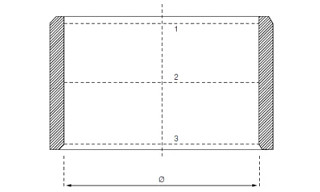
The position of the measurement planes
**I trade show the iglidur® plain bearings much larger than specified in the catalogue.**What is the reason for this?
iglidur®-Plain bearings are press-fit bearings for mounts with an H7 unit bore. This press-fitting of the bearing fixes the bearing in the housing on the one hand, and on the other hand it shapes the inner diameter of the plain bearing.
The bearing is tested in a hole with the smallest dimensions. If the bearings are measured in the non-pressed-in state, they are larger in both the outer and inner diameter by the press-fit interference than in the installed state.
Despite careful manufacture and assembly of the bearing, deviations and questions may arise in connection with the installation height and tolerances. Possible reasons for this may be
hole is not chamfered correctly - the bearing scrapes on the outside.
A centring pin was used, which widened the bearing on the inside when it was pressed in.
The hole does not correspond to the H7 tolerance.
The housing is made of a soft material that was widened by the bearing during press-fitting.
The shaft is not h-toleranced.
The measurement is not within the measuring lines.
**I only need a few plain bearings. So price is not a decisive factor for me.**Which iglidur® bearing is the best?
Unfortunately, there is no such thing as "the best iglidur® bearing". Even the most expensive bearing is not the most durable in every application. But there is the best iglidur® bearing for your application.
It is important to always make the bearing selection depending on the application. The more you know about the application, the more precisely you can select the most technically and economically sensible bearing.
Our iglidur® product finder and our iglidur® service life calculator are available online for this purpose. If you don't have the opportunity or leisure to familiarise yourself with these tools, simply give us your application data and we will do the rest.
Is the colour of a iglidur® plain bearing freely selectable?
Unfortunately no, the colour is usually determined by the respective material composition or there are often only individual dyes that are suitable for a material and at the same time do not negatively affect the tribological specification. Above all, the wear behaviour depends on the material composition (which also includes the colourant) and a new colour additive often increases the wear many times over. This means that every iglidur® material has a specific colour, although some materials look almost identical.

Press-fitting of an iglidur® plain bearing
How is a iglidur® plain bearing mounted?
iglidur®Plain bearings are press-fit bushings. The inner diameter is only set after pressing into the H7-housing bore with the corresponding tolerance. The press-fit interference can be up to 2% of the inner diameter. This ensures a secure press fit of the bearing. Axial or radial displacements in the housing are thus reliably avoided.
The hole in the housing should be manufactured to tolerance H7 for all bearings and be as smooth, even and chamfered as possible. Assembly is carried out with a flat press. The use of centring or calibration mandrels can damage the bearing and lead to greater clearance.
What recommendations are there for bonding iglidur® plain bearings?
In standard cases, we have had very good experiences with instant adhesives (e.g. Loctite 401). With materials that are difficult to bond, such as iglidur® J, significantly better results are achieved with 2-component systems (e.g. Loctite 406 + Primer 770). We have had good experiences with epoxy resin systems (e.g. Hysol) for applications with increased temperatures.
Furthermore, it is important for every bonded joint that the workpieces are thoroughly cleaned and free of grease. This can be done with professional cleaners, for example, but also with simple quick degreasers. Roughening the contact surfaces also supports the bonding effect.
In general, bonding can only have a supporting effect and cannot completely replace the press fit.
Why is an iglidur® polymer bearing environmentally friendly?

1.1 igus® iglidur® N54 Plastic bushings consist of 54 per cent renewable raw materials.
In the words of Kermit the Frog: "it's not easy being green". " And while he may just be a hand puppet, Kermit is right - today many companies are doing everything they can to reduce their carbon footprint. However, becoming a greener company doesn't happen overnight. It is usually the end point of a series of changes that take place over time in different areas. So what contribution do iglidur® plastic plain bearings make? Even if it sounds mundane, the use of lubrication-free plastic bushings can significantly reduce harmful environmental influences.
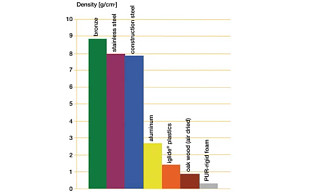
The heavier a component is, the more energy is needed to start it moving and keep it moving.
Four aspects of the environmental friendliness of iglidur® plastic plain bearings:
1. plastic bushings require no lubrication - which is good for the environment. It is estimated that almost four billion litres of industrial lubricants are used in the USA every year, of which around 40 percent end up in the environment. Thanks to continuous progress in the material development of tribologically optimised plastic plain bearings, igus® is able to offer more environmentally friendly alternatives to metal bushings for more and more applications. Unlike metal and bronze bearings, which require lubrication, every iglidur®plastic bearing has solid lubrication embedded in the material and therefore cannot be squeezed or washed out. This means that the bearings do not require oil or grease - so no contaminants are released into the environment.
2. plastic bushings are very light. This means that iglidur® bearings can also help to reduce fuel consumption and carbon dioxide emissions in outdoor equipment, motor vehicles and aeroplanes, for example. The weight reduction leads to lower masses and consequently to lower energy consumption.
3. the good chemical resistance of plastic bushings is a further ecological plus. Metals often have to be galvanised in an environmentally harmful, energy-intensive galvanising bath to achieve this effect.
4. less energy is required to produce a plastic bushing compared to a metal bearing. For example, the energy from approximately 15 litres of crude oil is required to produce 1 litre of aluminium; and the energy from approximately 11 litres of crude oil is required to produce 1 litre of steel. In comparison, on average only 1 litre of crude oil is required to produce 1 litre of plastic; and we expect this figure to be reduced even further due to ongoing developments in vegetable oil-based plastic.
What influence does the iglidur® polymer bearing have on the selection of the shaft?
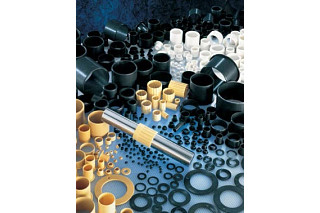
Variety of the iglidur® plastic bearings
1. cost aspects
Cost reduction is an important factor for most companies. The possibility of using a cost-effective shaft material depends largely on the choice of bearings.
For example, ball bearings require very hard (60HRC or higher) and smooth shafts. The same applies to bronze bearings: the shaft must be harder than the bronze material used. These requirements limit the choice of shaft. An inexpensive shaft material may not be suitable for the application or bearing.
Plastic bushings offer more options because they can be used for many different shafts. iglidur® plain bearings from igus® are available in a wide range of material variants:
This allows them to combine the least expensive shaft with the iglidur® bearing material that is most suitable for the application or the required service life. After all, the bearing and shaft only have to last as long as the service life of the entire machine/equipment. - Why choose an expensive shaft or an expensive bearing that will outlast the machine itself?
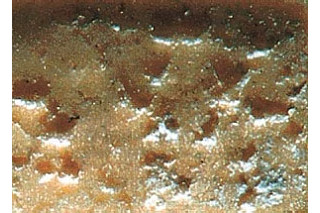
Erosion damage due to a shaft that is too smooth
2. wear aspects
In addition to the cost factors, a number of other things must be taken into account when considering the interaction between the shaft and the bearing system. Many factors can impair the function of the bearing used if they are not taken into account. If the shaft is too rough, wear can become a problem. A shaft that is too rough can act like a file and detach particles from the surface of the bearing as it moves. However, if the shaft is too smooth, an increase in friction can occur if the surfaces of the shaft and bearing adhere to each other. If there is a large difference between static and dynamic friction, a stick-slip effect can occur between two contacting surfaces. This usually manifests itself in a loud squeaking noise.
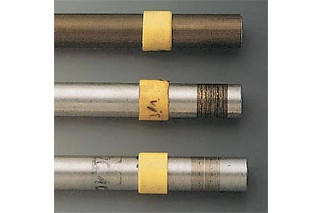
Wear tests with aluminium shafts
Another important aspect is the damage that abrasive particles can cause to bearings and shafts. If particles get between the bearing and shaft, both can be subject to increased wear. Dirt, dust, swarf and paper fibres are particles that can cause increased wear. Bearings with self-lubrication through embedded solid lubricants are much more durable in dirt because there is no grease or oil in the bearing point. This means that dirt particles are not attracted or stick to the shaft and bearing (as is the case with a well-lubricated bicycle chain, for example). - This also makes it possible to use less expensive shafts in applications with a high level of dirt. there are numerous shaft materials on the market, each of which can have a different effect on the wear of a bearing. These include aluminium, case-hardened steel, stainless steel and chrome-plated steel. Ultimately, the operating conditions and the service life requirements determine the shaft to be used. When selecting the right iglidur® plain bearing, basically any commercially available shaft type can be used.
Hard chrome-plated shafts, for example, are very hard but also smooth. The wear of iglidur®plastic plain bearings is usually lower on average with this type of shaft than with other shaft types. However, due to the low surface roughness, a stick-slip effect can occur in some cases. The various stainless steels are preferably used in wet areas and in food processing, while hard-coated aluminium is suitable for applications with a rather low load and the need to reduce weight. The best coefficient of friction is also achieved here in conjunction with iglidur® J.
How does a plug gauge measurement work?
1.1 igus® uses a plug gauge test, also known as a "go/no-go test", to ensure that our bearings meet the specifications and function properly after installation.
First, the bearings are pressed into a test fixture. It is important to ensure that the bearings are installed without damage. A bevelled edge is recommended for this - ideally 25-30 degrees. It is also advisable to use a press with a flat press to press in the bearing. This is the most efficient installation method. It also ensures the integrity of the bearing. If you use a hammer, for example, the bearing can tilt during installation.
1.2 igus® recommends using a press to install a plain bearing.
After the bearing has been installed, the actual plug gauge test is carried out. A "Go" means that the bolt falls through the bearing under its own weight, while a "No-Go" means that the bolt does not fall through the bearing or remains stuck. As a rule, the plug gauges are graduated to 0.01 mm, so that it is possible to determine very precisely from which dimension the respective plug gauge hangs.
A plug gauge test is the quality check with the greatest possible accuracy because the bolt behaves like a shaft in a real application and reflects the narrowest cross section of the bearing. It is precisely this aspect that is usually decisive for the application. Plug gauge tests are particularly suitable for plastic bearings, as the irrelevant "unevenness" of the bearing caused by injection moulding is not taken into account. Later in operation, during the running-in phase, when the unevenness of the bearing and the shaft is smoothed out, an ideal sliding surface is created.
The quality control of a bearing can also be carried out using other tests; however, inaccuracies can occur when these methods are applied to plastic bearings. In particular, the use of gauges should be avoided. Gauges should generally only be used for cursory quality checks, depending on the degree of accuracy. Depending on the pressure exerted by the gauge on the measuring point, the measurement may be falsified. A plug gauge test is therefore much more reliable.
Depending on accessibility, the described test can also be carried out directly on the series component (i.e. not in a specially manufactured test fixture).
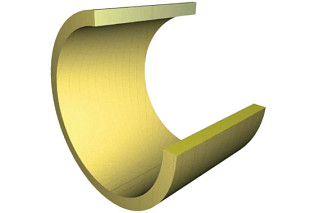
A homogeneously constructed plain bearing with calculable specifications, manufactured from a high-performance plastic.
What makes a self-lubricating polymer plain bearing so special?
Some engineers are reluctant to consider plastic bearings in their developments. Perhaps they have relied on metal or bronze bearings for years or simply doubt the suitability of plastic for difficult applications or environments. However, plastic bearings can withstand extreme temperatures, enormous loads and high speeds. Self-lubricating polymer bearings contain solid lubricants that are incorporated into the homogeneous material in tiny particles. In operation, these solid lubricants reduce the coefficient of friction. They cannot be washed out like grease or oil and, thanks to the homogeneous structure, they are distributed over the entire bearing wall thickness. In contrast to a layered structure, the entire bearing wall thickness is available as a wear zone with almost identical sliding properties.
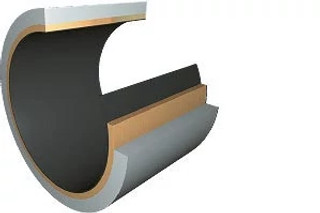
Composite bearings consist of various layers. The soft sliding layer can be easily damaged by foreign particles or improper handling.
Most iglidur® materials also contain reinforcing materials that increase compressive strength. High forces and edge loads can be withstood.
Due to this structure, iglidur® plain bearings can be used on many different shaft types - depending on the load, even on so-called soft shafts. This means that a cost-optimised combination can always be found.
iglidur® Bearings made from high-performance plastics should not be equated with bearings made from any standard plastic. For iglidur®plastic bearings, you can calculate the service life precisely, assuming the specific application parameters. igus® offers you an expert system - a special database in which load, speed, temperatures and other application parameters are entered. The system then determines the suitable plastic bearing and its expected service life based on test data.
iglidur®® plastic bearings represent the step from a simple plastic bushing to a tested and available machine component with calculable specifications. The main advantages summarised once again:
1. no troublesome lubricants: self-lubricating bearings contain solid lubricants. They reduce the coefficient of friction and are insensitive to dirt, dust and other contaminants.
2. maintenance-free: plastic bearings can replace bronze, metal-coated and injection moulding bearings in almost any application. Their resistance to dirt, dust and chemicals makes plastic bearings a "fit and forget" solution.
3. cost savings: Plastic bushings can reduce costs by up to 25 %. They are characterised by high wear resistance and a low coefficient of friction and can replace more expensive alternatives in a wide range of applications.
4. consistently low coefficient of friction and wear: Due to their design, plastic bearings guarantee a consistently low coefficient of friction and wear over the entire service life. Compared to metallic composite bearings, whose gliding layer can be damaged by dirt, for example, plastic bearings often last longer.
5. Absolutely corrosion-free and highly resistant to chemicals: plastic bearings cannot rust and are resistant to many environmental media.
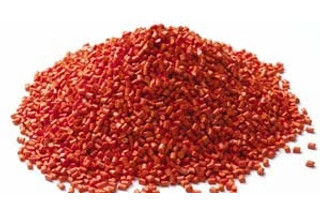
Every year, the igus® engineers develop more than 100 new material compounds
What is igus® 's core technical expertise in polymer plain bearings?
Over the years, the material developers at igus® have developed hundreds of material compounds, almost 40 of which have now found their way into the polymer plain bearing catalogue. The basic structure is usually the same:
1. base polymers, which predetermine the basic tribological, mechanical, thermal and chemical specifications of the bearing
2. fibres and fillers, which give the bearings a high mechanical load capacity
3. solid lubricants that significantly optimise wear and friction
igus® is constantly developing new polymer blends for every application and carries out almost 10,000 tests in its laboratory every year. Unlike most bearing manufacturers, igus® focuses exclusively on high-performance plastics and is able to process these cost-effectively into plain bearings using injection moulding: Agriculture, medical, automotive, packaging, aerospace, sports equipment, mechanical engineering and many more. In addition, igus® archives the test results in an extensive database. After testing a new polymer compound, the results are added to the data pool where they are available for a unique service life calculation programme: the expert system - where you can enter the maximum load, speed and temperatures of your application as well as shaft and housing materials to determine the best plastic bearing and its expected service life.
What factors influence the wear of a plain bearing?
1: Wear test with oscillating movement of a iglidur®plastic plain bearing from igus®.
Influencing factors:
Shaft selection: Different shaft materials are recommended for different plain bearings. Each shaft-bearing combination has different wear results.
load: As radial loads or surface pressures increase, the wear on the plain bearings also increases. Some plain bearings are designed for low loads, others for high loads.
Speed and type of movement: As the speed increases, so does the wear. The type of movement (oscillating, rotating or linear) also has a significant influence on the wear rate.
Temperature: Within certain limits, temperature has little effect on the wear of a bearing, but it can also accelerate wear exponentially. Plastic bearings are suitable for a wide temperature range, depending on the material selected. However, wear can increase significantly if the maximum application temperature is exceeded. With most iglidur® materials, the wear rate increases with rising temperatures. However, there are also exceptions that only reach their minimum wear at higher temperatures.
Dirty environment: Dirt and dust can accumulate between the shaft and bearing. This causes wear. Self-lubricating plastic bushings offer an advantage here: because they do not contain any oil, dirt and dust cannot stick to the shaft and damage the bearing.
Contact with chemicals: Plastic plain bearings are completely corrosion-free and resistant to a wide range of chemicals, but certain chemicals can even change the structural specification of a plain bearing, reducing the hardness of the bearing and increasing wear.
2: Wear tests with different shaft types.
The following applies to all these points: the more precisely I know my application and the parameters addressed, the more specifically a iglidur® material selection and a service life extrapolation can be made. Selecting the right material is crucial for service life.
How does bearing wear affect the bearing clearance?
Bearing wear means material removal on the sliding surface, i.e. usually on the inner diameter of the bearing.
The clearance between the bearing and shaft is calculated from the tolerances of the bearing and shaft.
The actual starting clearance during commissioning is the difference between the measured actual inner diameter of the bearing and the measured actual outer diameter of the shaft. Wear on the bearing inner diameter leads to an increase in diameter and thus to an increase in clearance.
As iglidur® plain bearings do not have a layered structure and therefore the entire wall thickness is available as a wear zone, there is no wear limit specified by the bearing. Instead, the wear limit is determined by the maximum clearance permitted in an application. This can vary greatly depending on the application and user requirements. Precision control valves, for example, only allow a few hundredths of wear (and therefore an increase in play). In agricultural applications with shaft diameters greater than 50 mm, a clearance of significantly more than one millimetre is often uncritical.
When is a xiros® polymer ball bearing used instead of an iglidur® polymer plain bearing?
In general, it can be said that xiros® polymer ball bearings are preferable to iglidur® plain bearings wherever rotating movements with speeds above 1.5 metres/second can occur permanently at low loads. The significantly lower coefficient of friction of the polymer ball bearings compared to plain bearings ensures lower heat generation and lower wear.
The inner diameter of the ball bearing is particularly important. The smaller the inner diameter, the fewer revolutions the bearing has to perform per minute, which in turn has a positive effect on heat generation and dissipation. If the diameter of the ball bearing increases, the maximum load capacity increases, while the maximum possible speed decreases.
Our double-row polymer ball bearings are suitable for applications with higher load capacities. For applications involving dirt and abrasive materials, we offer xiros® ball bearings with a cover disc."
What is the stick-slip effect?
The stick-slip effect refers to the jerky sliding of solid bodies moving against each other. This phenomenon occurs when a body is moved whose static friction is significantly greater than the sliding friction.
Imagine a heavy cardboard box that you want to push across a smooth floor. The box is heavy, which is why we have to exert a lot of force to overcome the static friction - i.e. the resistance of the box to move. The cardboard slides. Due to the smooth surface and the resulting low sliding friction, the carton quickly speeds up. However, the rapid sliding movement of the cardboard means that we can transfer less force to the cardboard. Eventually, the force acting on the carton is no longer sufficient to overcome its static friction. The carton comes to a standstill, which means we have to apply a lot of force again to overcome it and the process repeats itself. Sticking - releasing - sliding - braking - sticking - releasing... in reality, this effect happens much faster and manifests itself in a stutter. .
This phenomenon occurs in a wide variety of areas. Windscreen wipers stutter across the windscreen of a car. Chalk squeaks when you write on a sheet of paper if you hold it at the wrong angle. Door hinges squeak. And stringed instruments such as the violin or cello would not work, because their sounds are caused by vibrations and oscillations between the strings and the tendons of the sag.
With tribologically optimised materials, however, this effect is undesirable. The vibrations caused are transferred to the overall construction and cause noises that are often perceived as annoying squeaking or creaking. The desired sliding movement becomes an irregular stuttering and increases wear on the bearing. These effects can be counteracted by minimising the difference between sliding and static friction, using vibration-damping materials, improving the rigidity of the overall structure (see preloaded bearing) or separating the friction partners involved (e.g. by lubrication)

1. force > Static friction
The force (arrow 1) overcomes the static friction (arrow 2). The carton starts to move.
2nd force = static friction
The static friction becomes sliding friction (arrow 2) and the carton slides quickly.
3rd force < Sliding friction
The force (arrow 1) is not sufficient to overcome the sliding friction (arrow 2).
4. force < static friction
The sliding friction becomes static friction. The force is not sufficient, the box stops.

Are iglidur® plain bearings RoHS-compliant and what is RoHS anyway?
The EC guideline 2002/95/EC ("RoHS 1") behind the keyword "RoHS" was replaced on 3 January 2013 by EC guideline 2011/65/RU ("RoHS 2").
The guideline regulates the restriction of undesirable substances in electrical and electronic equipment placed on the market in the EU. The abbreviation RoHS stands for "Restriction of (the use of certain) Hazardous Substances".
As it is not technically feasible to completely dispense with many materials and products, specific limit values have been defined.
The substances concerned are lead, mercury, cadmium, hexavalent chromium, polybrominated biphenyls (PBB) and diphenyl ether (PBDE), which are frequently used in electronics. Examples of applications include the use of lead in soldering or as a component of metallic composite bearings and the use of PBBs as flame retardants. These substances are also found in numerous metallic alloys.
As can be seen from a glance at the substances and these application examples, these substances do not play a role in thermoplastic compounds such as our iglidur® materials. The ingredients of our iglidur® materials therefore fulfil the requirements of guideline 2011/65/EU (RoHS 2). We will be happy to send you explicit confirmation of this upon request.
Are iglidur® plain bearings resistant to chemicals?
Contact with chemicals is often a particular challenge for plain bearings. For example, disinfectants or cleaning agents are used in the food industry or the bearings come into contact with coolants. iglidur® Materials are tested for their resistance in conjunction with a variety of chemicals. They can therefore be used in contact with chemicals, disinfectants or cleaning agents. The iglidur® materials of the "H family" (iglidur® H1, H370 etc.) and iglidur® X are considered to be particularly resistant to chemicals.
What is a plain bearing?
In mechanical engineering, the term plain bearing refers to components that decouple surfaces that move relative to each other. This protects these surfaces from wear-related damage and reduces the coefficient of friction and thus the energy required for movement, as well as heat generation.
When are plain bearings used?
Plain bearings are used wherever friction and wear on surfaces that are subject to movement need to be reduced. The fields of application range from the mounting of bridges that expand under the influence of temperature, to the moving elements of an office chair, to the pinhead-sized plain bearing in electric toothbrushes.
In general, plain bearings are particularly suitable for applications in which the combination of load or surface pressure and intensity of movement is not too high. This is referred to as the pv value, which is the product of surface pressure in N/mm² and speed in m/s. The maximum permissible pv value is specified by the manufacturer for most plain bearings. If this is exceeded due to the application conditions, the plain bearing is unsuitable for these conditions. In this case, either additional cooling or the use of a ball bearing must be considered. However, with sufficient cooling or reduction of friction through lubrication, plain bearings can also be used with very high PV values.
What does a plain bearing do?
Plain bearings decouple moving parts from each other to protect their surfaces from wear and to reduce the friction between them. Due to the lower coefficient of friction, the force required for the movement and therefore the energy can be reduced.
Which is better plain or ball bearing?
Plain bearings and ball bearings are each based on different functional principles and therefore have different specifications. These specifications make them more or less suitable for different applications. Plain bearings are one-piece components that consist of one or more materials and are designed to reduce friction either through integrated solid lubricants or additionally applied lubrication. They are particularly suitable for applications where a cost-effective and space-saving solution is required and where the combination of load and speed is not too high. Ball bearings consist of rings between which several balls or rollers are mounted. These rotate around the inner ring of the ball bearing and thus enable the relative movement of the adjacent components. The advantage of ball bearings is their precision, as they can be designed to be almost clearance-free, as well as their particularly low rolling resistance. Similar to the sliding friction coefficient of plain bearings, this helps to make applications particularly smooth-running. However, plain bearings also require significantly more installation space. They are heavier, often more expensive and require special protection against dirt ingress and loss of lubricant.
Consulting
I look forward to answering your questions

Shipping and consultation
In person:
Monday to Friday from 7 am - 8 pm.
Saturdays from 8 am- 12 pm.
Online:
24h
WhatsApp-Service:
Montag – Freitag: 8 – 16 Uhr